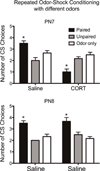Defining age limits of the sensitive period for attachment learning in rat pups
- PMID: 20583142
- PMCID: PMC3602827
- DOI: 10.1002/dev.20448
Defining age limits of the sensitive period for attachment learning in rat pups
Abstract
Enhanced odor preference learning and attenuated fear learning characterizes rat pups' attachment learning Sensitive Period for learning the maternal odor. This period terminates at 10 days old (PN10) with increasing endogenous levels of the stress hormone, corticosterone. Increasing Sensitive Period pups' corticosterone prematurely terminates the Sensitive Period, while decreasing corticosterone in older pups delays Sensitive Period termination. Here we extend these findings and define the age range corticosterone alters learning and question whether corticosterone permanently terminates the Sensitive Period. Pups were odor-0.5 mA shock conditioned with either corticosterone increased (PN5-6; 4 mg/kg vs. saline) or decreased (PN15-16; naturally by maternal presence or corticosterone synthesis blocker, Metyrapone). Finally, PN7-8 pups were conditioned with corticosterone and reconditioned without corticosterone to assess whether the Sensitive Period was permanently terminated. Results indicate developmental limits for corticosterone regulation of pup learning are PN6 through PN15. Furthermore, inducing precocious corticosterone induced fear learning was not permanent, since reconditioning without corticosterone enabled odor preference learning. Results suggest pups are protected from learning aversions to maternal odor until approaching weaning.
Figures




Similar articles
-
Dual circuitry for odor-shock conditioning during infancy: corticosterone switches between fear and attraction via amygdala.J Neurosci. 2006 Jun 21;26(25):6737-48. doi: 10.1523/JNEUROSCI.0499-06.2006. J Neurosci. 2006. PMID: 16793881 Free PMC article.
-
Maternal attenuation of hypothalamic paraventricular nucleus norepinephrine switches avoidance learning to preference learning in preweanling rat pups.Horm Behav. 2007 Sep;52(3):391-400. doi: 10.1016/j.yhbeh.2007.06.004. Epub 2007 Jun 29. Horm Behav. 2007. PMID: 17675020 Free PMC article.
-
Early-life stress disrupts attachment learning: the role of amygdala corticosterone, locus ceruleus corticotropin releasing hormone, and olfactory bulb norepinephrine.J Neurosci. 2009 Dec 16;29(50):15745-55. doi: 10.1523/JNEUROSCI.4106-09.2009. J Neurosci. 2009. PMID: 20016090 Free PMC article.
-
Rodent model of infant attachment learning and stress.Dev Psychobiol. 2010 Nov;52(7):651-60. doi: 10.1002/dev.20482. Dev Psychobiol. 2010. PMID: 20730787 Free PMC article. Review.
-
The neurobiology of safety and threat learning in infancy.Neurobiol Learn Mem. 2017 Sep;143:49-58. doi: 10.1016/j.nlm.2016.10.015. Epub 2016 Nov 4. Neurobiol Learn Mem. 2017. PMID: 27826033 Free PMC article. Review.
Cited by
-
Maternal Odor Exposure Modulates Acceptance of a Bitter Taste in Newborn and Infant Rats.Front Psychol. 2018 Jul 31;9:1327. doi: 10.3389/fpsyg.2018.01327. eCollection 2018. Front Psychol. 2018. PMID: 30108539 Free PMC article.
-
Using a Developmental Ecology Framework to Align Fear Neurobiology Across Species.Annu Rev Clin Psychol. 2019 May 7;15:345-369. doi: 10.1146/annurev-clinpsy-050718-095727. Epub 2019 Feb 20. Annu Rev Clin Psychol. 2019. PMID: 30786246 Free PMC article. Review.
-
Mechanisms and functional implications of social buffering in infants: Lessons from animal models.Soc Neurosci. 2015;10(5):500-11. doi: 10.1080/17470919.2015.1087425. Epub 2015 Sep 16. Soc Neurosci. 2015. PMID: 26324338 Free PMC article.
-
Developmental neurobiology of the rat attachment system and its modulation by stress.Behav Sci (Basel). 2012 Jun 1;2(2):79-102. doi: 10.3390/bs2020079. Behav Sci (Basel). 2012. PMID: 23626910 Free PMC article.
-
Developmental transitions in amygdala PKC isoforms and AMPA receptor expression associated with threat memory in infant rats.Sci Rep. 2018 Oct 2;8(1):14679. doi: 10.1038/s41598-018-32762-y. Sci Rep. 2018. PMID: 30279521 Free PMC article.
References
-
- Alberts JR, May B. Nonnutritive, thermotactile induction of filial huddling in rat pups. Developmental Psychobiology. 1984;17(2):161–181. - PubMed
-
- Armstrong VL, Brunet PM, He C, Nishimura M, Poole HL, Spector FJ. What is so critical? A commentary on the reexamination of critical periods. Developmental Psychobiology. 2006a;48(4):326–331. - PubMed
-
- Armstrong VL, Brunet PM, He C, Nishimura M, Poole HL, Spector FJ. When is a description needed for an explanation: Rejoiner. Developmental Psychobiology. 2006b;48(4):335–336. - PubMed
Publication types
MeSH terms
Substances
Grants and funding
LinkOut - more resources
Full Text Sources

